Information Technology in Tourism: Advantages, Risks, and Strategies
VerifiedAdded on 2020/02/23
|9
|1824
|207
Report
AI Summary
This report examines the critical role of Information Technology (IT) in the tourism sector. It highlights the increasing need for IT in tourism to enhance collaboration, reduce costs, and reach a wider audience through e-marketing. The report details the importance of IT for business survival, emphasizing the shift towards online services and the automation of processes. It outlines the requirements for implementing IT, including website design, equipment, and employee training. The report further explores the various uses of IT in tourism, benefiting both employees and customers by streamlining communication and providing access to information. It also discusses the advantages of IT, such as improved communication, online advertising, and enhanced customer experiences. The report also addresses IT risks, including security, privacy, and confidentiality concerns. Finally, it emphasizes the need for regular monitoring and maintenance to ensure the system's effectiveness. The report concludes that the implementation of IT can significantly benefit the tourism sector, while also acknowledging the need for careful consideration of potential risks.
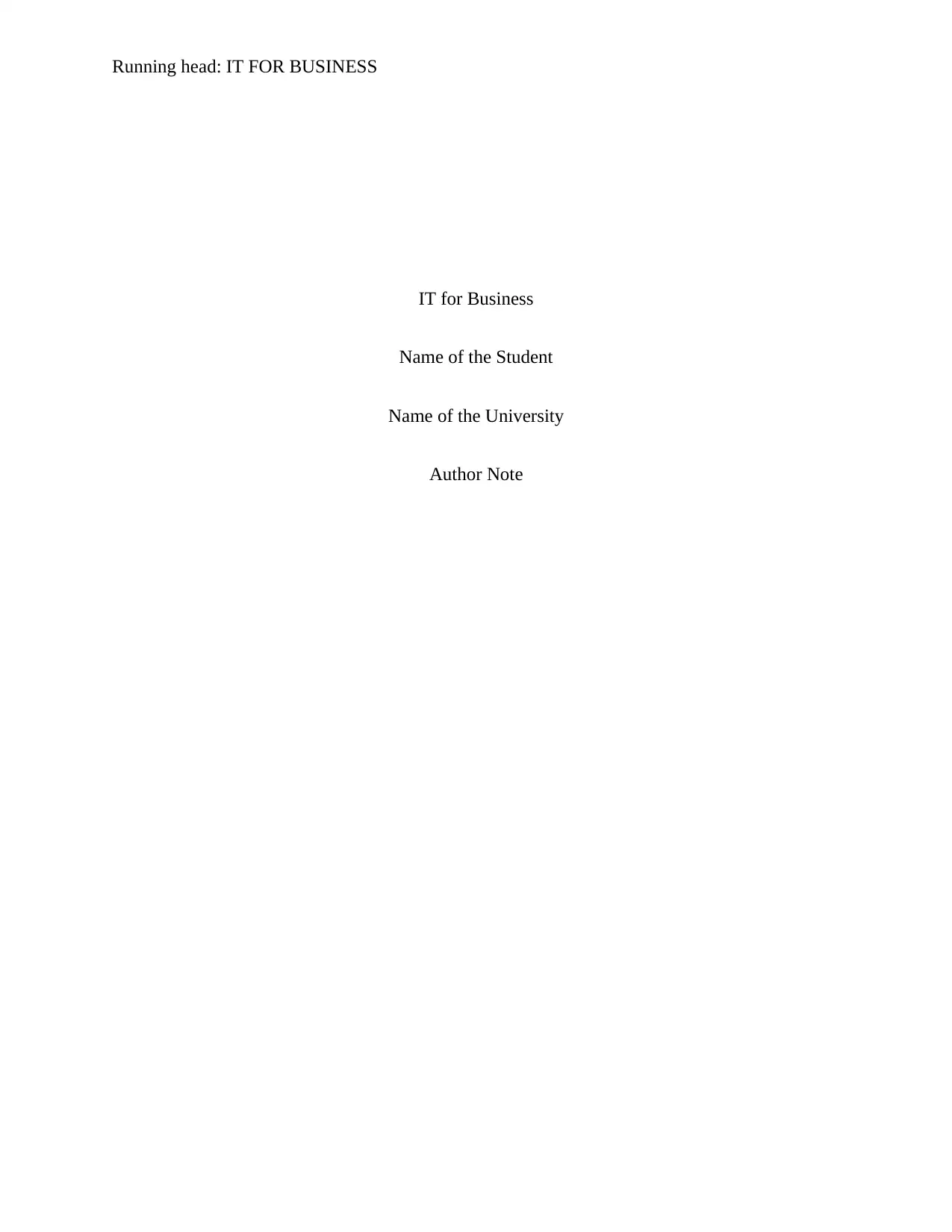
Running head: IT FOR BUSINESS
IT for Business
Name of the Student
Name of the University
Author Note
IT for Business
Name of the Student
Name of the University
Author Note
Paraphrase This Document
Need a fresh take? Get an instant paraphrase of this document with our AI Paraphraser
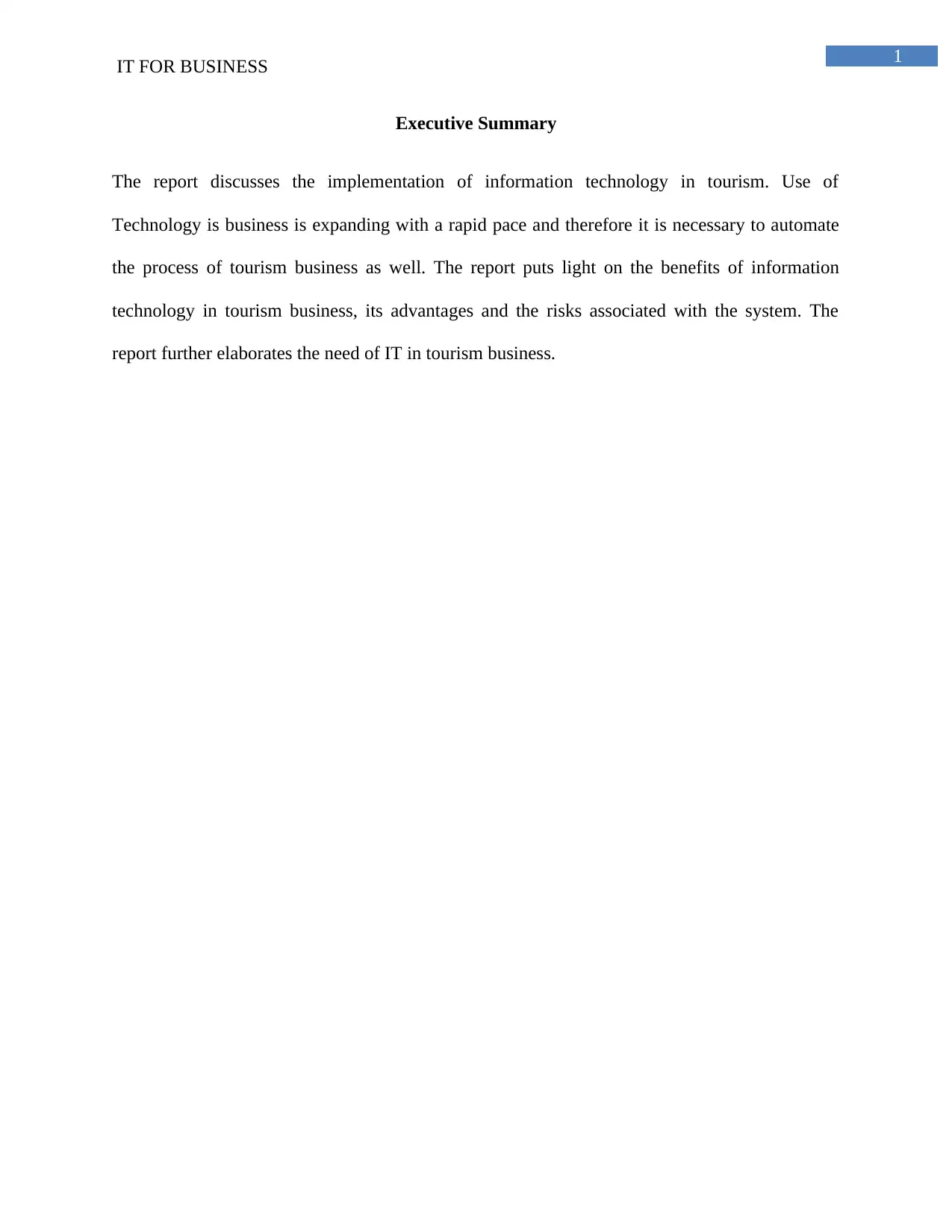
1
IT FOR BUSINESS
Executive Summary
The report discusses the implementation of information technology in tourism. Use of
Technology is business is expanding with a rapid pace and therefore it is necessary to automate
the process of tourism business as well. The report puts light on the benefits of information
technology in tourism business, its advantages and the risks associated with the system. The
report further elaborates the need of IT in tourism business.
IT FOR BUSINESS
Executive Summary
The report discusses the implementation of information technology in tourism. Use of
Technology is business is expanding with a rapid pace and therefore it is necessary to automate
the process of tourism business as well. The report puts light on the benefits of information
technology in tourism business, its advantages and the risks associated with the system. The
report further elaborates the need of IT in tourism business.
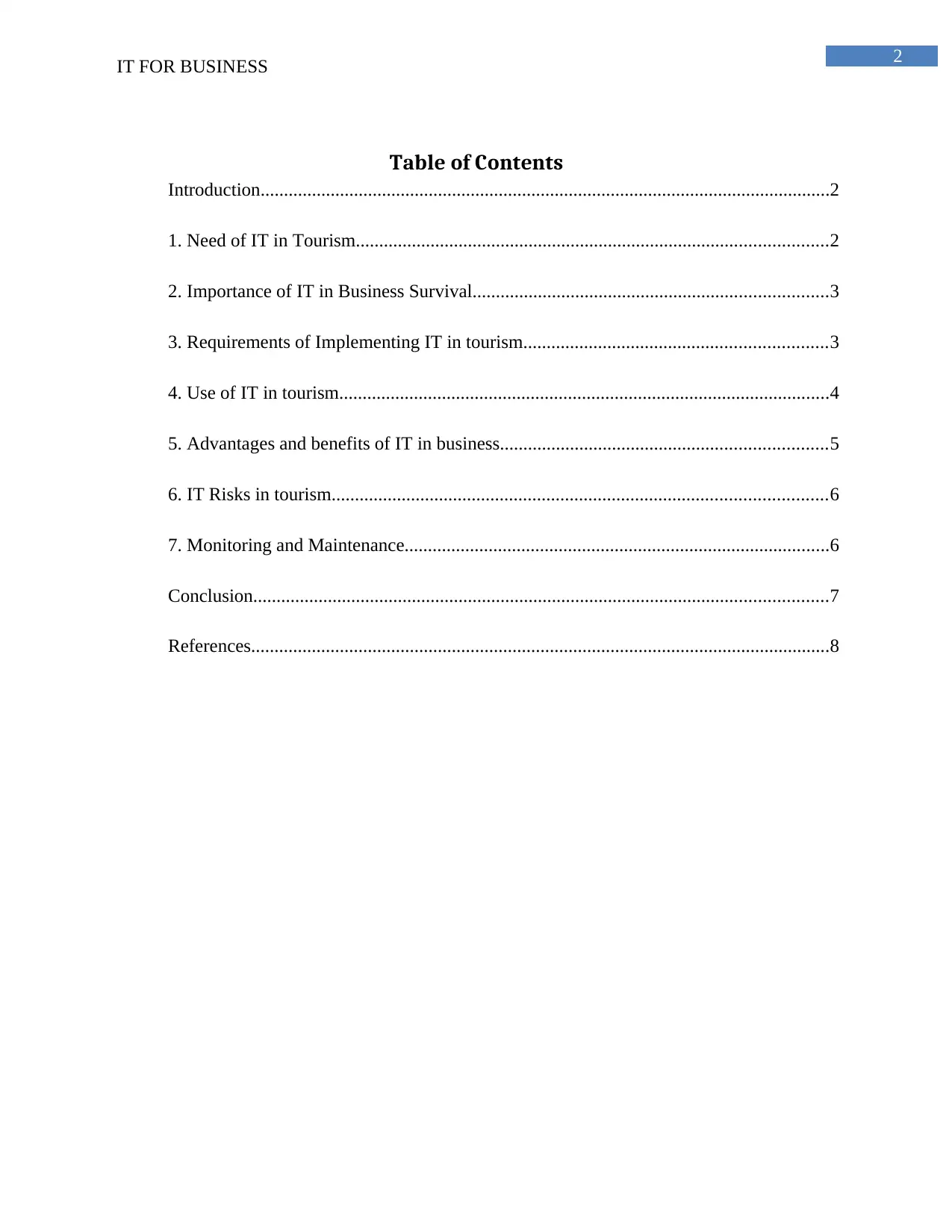
2
IT FOR BUSINESS
Table of Contents
Introduction..........................................................................................................................2
1. Need of IT in Tourism.....................................................................................................2
2. Importance of IT in Business Survival............................................................................3
3. Requirements of Implementing IT in tourism.................................................................3
4. Use of IT in tourism.........................................................................................................4
5. Advantages and benefits of IT in business......................................................................5
6. IT Risks in tourism..........................................................................................................6
7. Monitoring and Maintenance...........................................................................................6
Conclusion...........................................................................................................................7
References............................................................................................................................8
IT FOR BUSINESS
Table of Contents
Introduction..........................................................................................................................2
1. Need of IT in Tourism.....................................................................................................2
2. Importance of IT in Business Survival............................................................................3
3. Requirements of Implementing IT in tourism.................................................................3
4. Use of IT in tourism.........................................................................................................4
5. Advantages and benefits of IT in business......................................................................5
6. IT Risks in tourism..........................................................................................................6
7. Monitoring and Maintenance...........................................................................................6
Conclusion...........................................................................................................................7
References............................................................................................................................8
⊘ This is a preview!⊘
Do you want full access?
Subscribe today to unlock all pages.

Trusted by 1+ million students worldwide
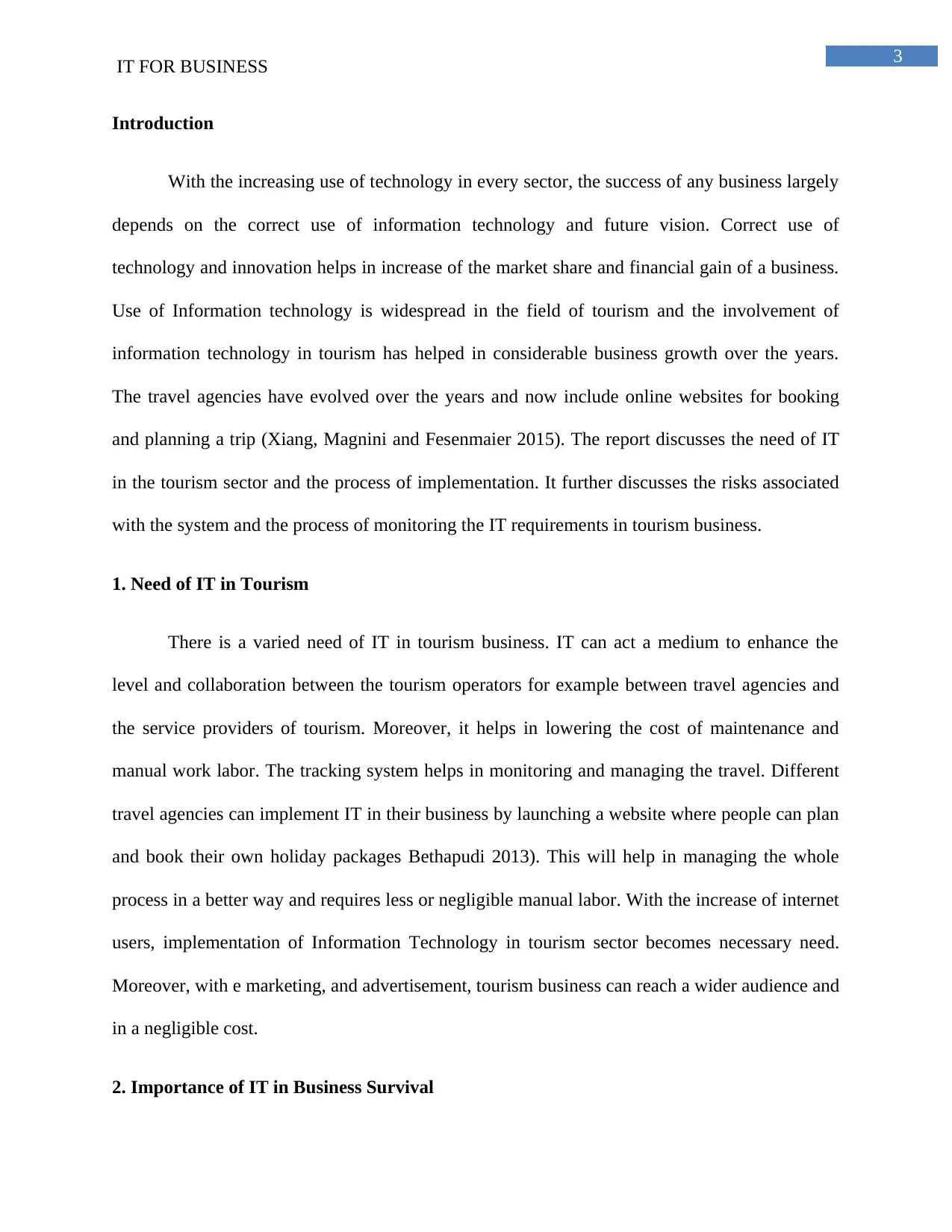
3
IT FOR BUSINESS
Introduction
With the increasing use of technology in every sector, the success of any business largely
depends on the correct use of information technology and future vision. Correct use of
technology and innovation helps in increase of the market share and financial gain of a business.
Use of Information technology is widespread in the field of tourism and the involvement of
information technology in tourism has helped in considerable business growth over the years.
The travel agencies have evolved over the years and now include online websites for booking
and planning a trip (Xiang, Magnini and Fesenmaier 2015). The report discusses the need of IT
in the tourism sector and the process of implementation. It further discusses the risks associated
with the system and the process of monitoring the IT requirements in tourism business.
1. Need of IT in Tourism
There is a varied need of IT in tourism business. IT can act a medium to enhance the
level and collaboration between the tourism operators for example between travel agencies and
the service providers of tourism. Moreover, it helps in lowering the cost of maintenance and
manual work labor. The tracking system helps in monitoring and managing the travel. Different
travel agencies can implement IT in their business by launching a website where people can plan
and book their own holiday packages Bethapudi 2013). This will help in managing the whole
process in a better way and requires less or negligible manual labor. With the increase of internet
users, implementation of Information Technology in tourism sector becomes necessary need.
Moreover, with e marketing, and advertisement, tourism business can reach a wider audience and
in a negligible cost.
2. Importance of IT in Business Survival
IT FOR BUSINESS
Introduction
With the increasing use of technology in every sector, the success of any business largely
depends on the correct use of information technology and future vision. Correct use of
technology and innovation helps in increase of the market share and financial gain of a business.
Use of Information technology is widespread in the field of tourism and the involvement of
information technology in tourism has helped in considerable business growth over the years.
The travel agencies have evolved over the years and now include online websites for booking
and planning a trip (Xiang, Magnini and Fesenmaier 2015). The report discusses the need of IT
in the tourism sector and the process of implementation. It further discusses the risks associated
with the system and the process of monitoring the IT requirements in tourism business.
1. Need of IT in Tourism
There is a varied need of IT in tourism business. IT can act a medium to enhance the
level and collaboration between the tourism operators for example between travel agencies and
the service providers of tourism. Moreover, it helps in lowering the cost of maintenance and
manual work labor. The tracking system helps in monitoring and managing the travel. Different
travel agencies can implement IT in their business by launching a website where people can plan
and book their own holiday packages Bethapudi 2013). This will help in managing the whole
process in a better way and requires less or negligible manual labor. With the increase of internet
users, implementation of Information Technology in tourism sector becomes necessary need.
Moreover, with e marketing, and advertisement, tourism business can reach a wider audience and
in a negligible cost.
2. Importance of IT in Business Survival
Paraphrase This Document
Need a fresh take? Get an instant paraphrase of this document with our AI Paraphraser
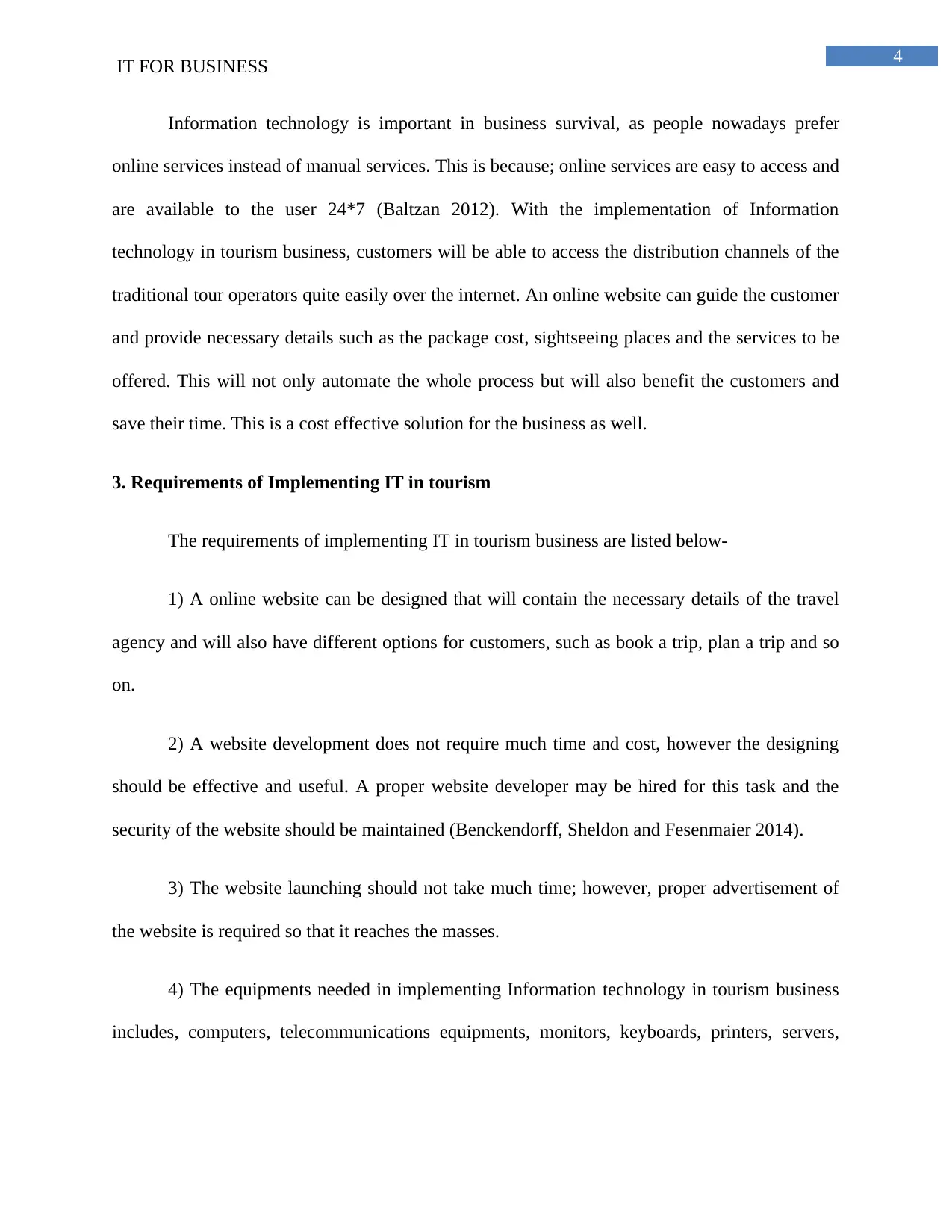
4
IT FOR BUSINESS
Information technology is important in business survival, as people nowadays prefer
online services instead of manual services. This is because; online services are easy to access and
are available to the user 24*7 (Baltzan 2012). With the implementation of Information
technology in tourism business, customers will be able to access the distribution channels of the
traditional tour operators quite easily over the internet. An online website can guide the customer
and provide necessary details such as the package cost, sightseeing places and the services to be
offered. This will not only automate the whole process but will also benefit the customers and
save their time. This is a cost effective solution for the business as well.
3. Requirements of Implementing IT in tourism
The requirements of implementing IT in tourism business are listed below-
1) A online website can be designed that will contain the necessary details of the travel
agency and will also have different options for customers, such as book a trip, plan a trip and so
on.
2) A website development does not require much time and cost, however the designing
should be effective and useful. A proper website developer may be hired for this task and the
security of the website should be maintained (Benckendorff, Sheldon and Fesenmaier 2014).
3) The website launching should not take much time; however, proper advertisement of
the website is required so that it reaches the masses.
4) The equipments needed in implementing Information technology in tourism business
includes, computers, telecommunications equipments, monitors, keyboards, printers, servers,
IT FOR BUSINESS
Information technology is important in business survival, as people nowadays prefer
online services instead of manual services. This is because; online services are easy to access and
are available to the user 24*7 (Baltzan 2012). With the implementation of Information
technology in tourism business, customers will be able to access the distribution channels of the
traditional tour operators quite easily over the internet. An online website can guide the customer
and provide necessary details such as the package cost, sightseeing places and the services to be
offered. This will not only automate the whole process but will also benefit the customers and
save their time. This is a cost effective solution for the business as well.
3. Requirements of Implementing IT in tourism
The requirements of implementing IT in tourism business are listed below-
1) A online website can be designed that will contain the necessary details of the travel
agency and will also have different options for customers, such as book a trip, plan a trip and so
on.
2) A website development does not require much time and cost, however the designing
should be effective and useful. A proper website developer may be hired for this task and the
security of the website should be maintained (Benckendorff, Sheldon and Fesenmaier 2014).
3) The website launching should not take much time; however, proper advertisement of
the website is required so that it reaches the masses.
4) The equipments needed in implementing Information technology in tourism business
includes, computers, telecommunications equipments, monitors, keyboards, printers, servers,
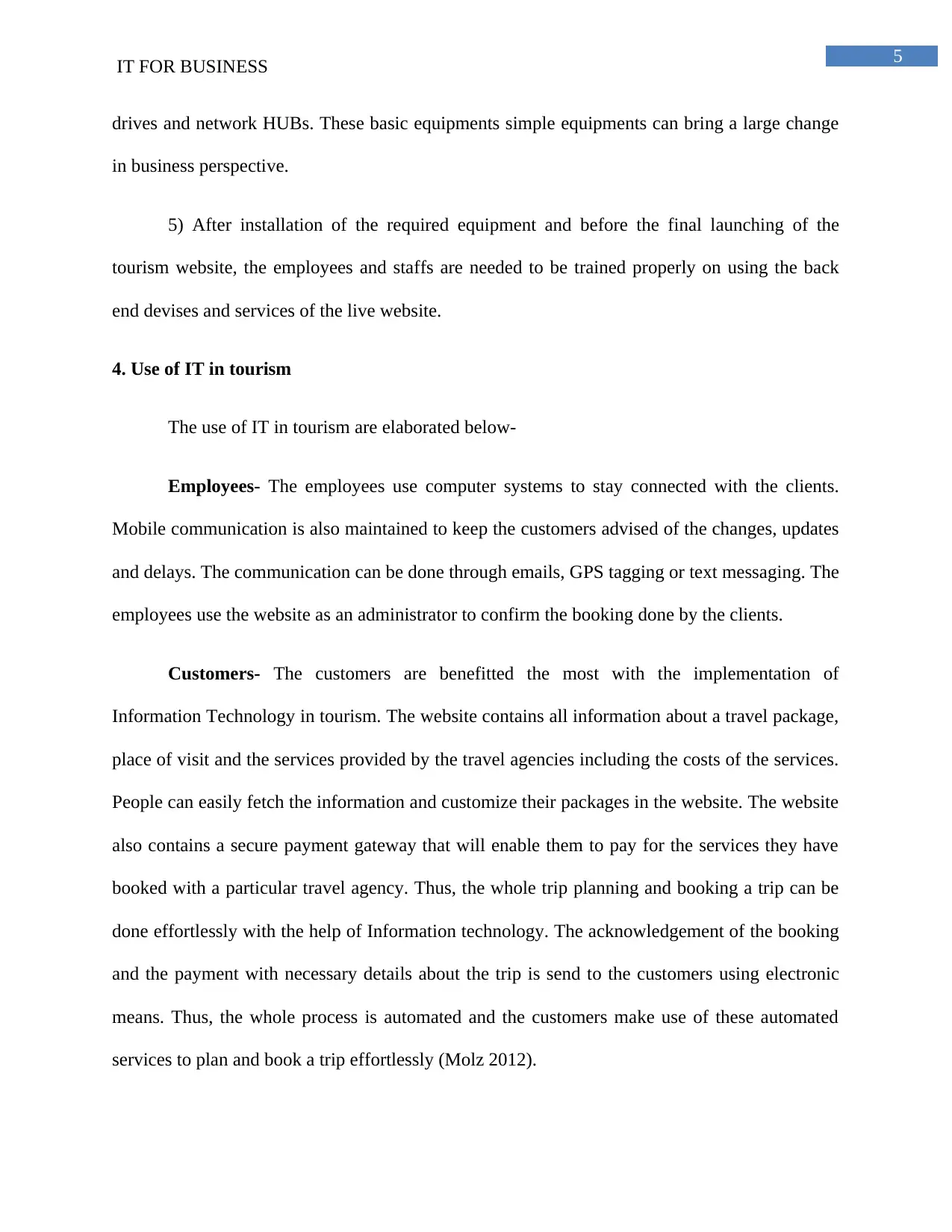
5
IT FOR BUSINESS
drives and network HUBs. These basic equipments simple equipments can bring a large change
in business perspective.
5) After installation of the required equipment and before the final launching of the
tourism website, the employees and staffs are needed to be trained properly on using the back
end devises and services of the live website.
4. Use of IT in tourism
The use of IT in tourism are elaborated below-
Employees- The employees use computer systems to stay connected with the clients.
Mobile communication is also maintained to keep the customers advised of the changes, updates
and delays. The communication can be done through emails, GPS tagging or text messaging. The
employees use the website as an administrator to confirm the booking done by the clients.
Customers- The customers are benefitted the most with the implementation of
Information Technology in tourism. The website contains all information about a travel package,
place of visit and the services provided by the travel agencies including the costs of the services.
People can easily fetch the information and customize their packages in the website. The website
also contains a secure payment gateway that will enable them to pay for the services they have
booked with a particular travel agency. Thus, the whole trip planning and booking a trip can be
done effortlessly with the help of Information technology. The acknowledgement of the booking
and the payment with necessary details about the trip is send to the customers using electronic
means. Thus, the whole process is automated and the customers make use of these automated
services to plan and book a trip effortlessly (Molz 2012).
IT FOR BUSINESS
drives and network HUBs. These basic equipments simple equipments can bring a large change
in business perspective.
5) After installation of the required equipment and before the final launching of the
tourism website, the employees and staffs are needed to be trained properly on using the back
end devises and services of the live website.
4. Use of IT in tourism
The use of IT in tourism are elaborated below-
Employees- The employees use computer systems to stay connected with the clients.
Mobile communication is also maintained to keep the customers advised of the changes, updates
and delays. The communication can be done through emails, GPS tagging or text messaging. The
employees use the website as an administrator to confirm the booking done by the clients.
Customers- The customers are benefitted the most with the implementation of
Information Technology in tourism. The website contains all information about a travel package,
place of visit and the services provided by the travel agencies including the costs of the services.
People can easily fetch the information and customize their packages in the website. The website
also contains a secure payment gateway that will enable them to pay for the services they have
booked with a particular travel agency. Thus, the whole trip planning and booking a trip can be
done effortlessly with the help of Information technology. The acknowledgement of the booking
and the payment with necessary details about the trip is send to the customers using electronic
means. Thus, the whole process is automated and the customers make use of these automated
services to plan and book a trip effortlessly (Molz 2012).
⊘ This is a preview!⊘
Do you want full access?
Subscribe today to unlock all pages.

Trusted by 1+ million students worldwide
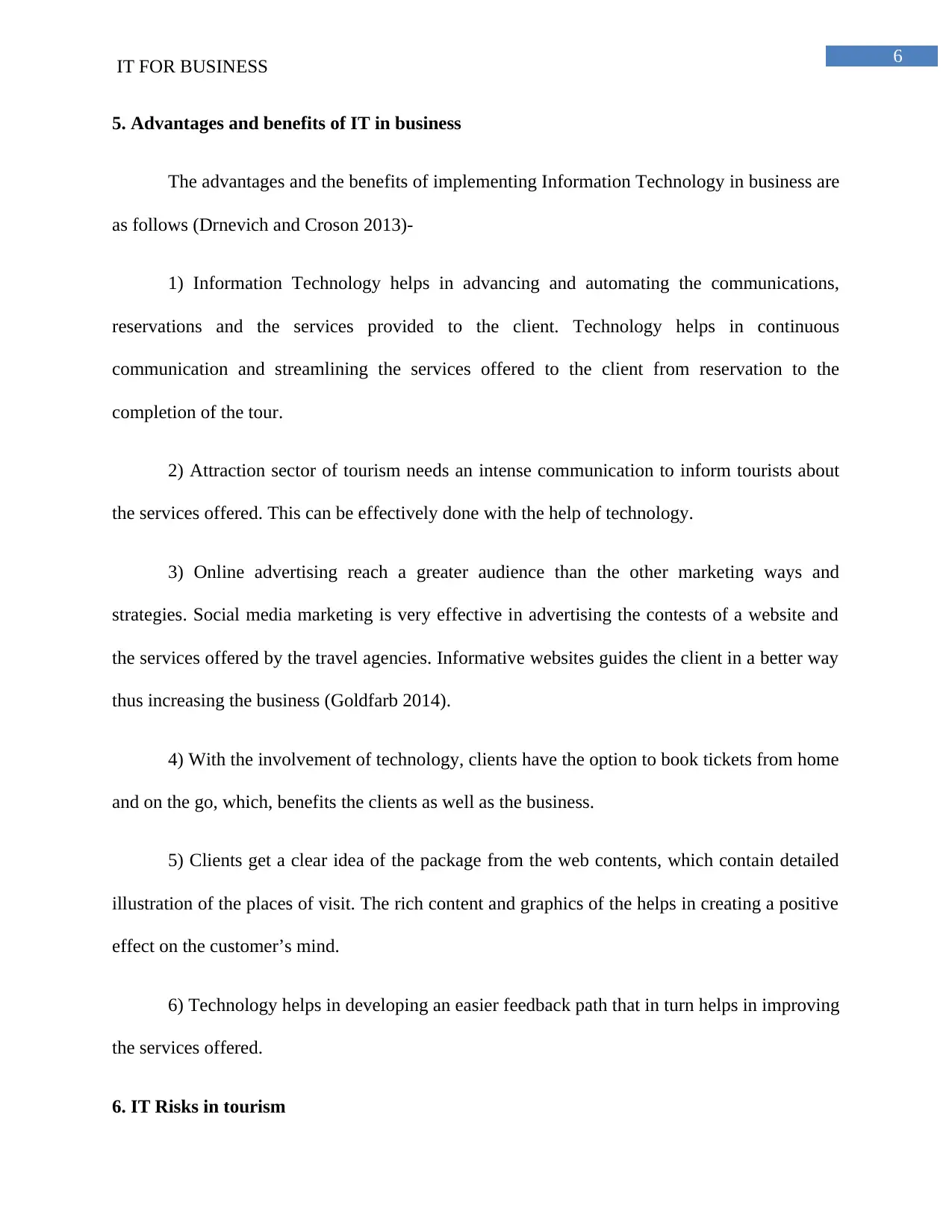
6
IT FOR BUSINESS
5. Advantages and benefits of IT in business
The advantages and the benefits of implementing Information Technology in business are
as follows (Drnevich and Croson 2013)-
1) Information Technology helps in advancing and automating the communications,
reservations and the services provided to the client. Technology helps in continuous
communication and streamlining the services offered to the client from reservation to the
completion of the tour.
2) Attraction sector of tourism needs an intense communication to inform tourists about
the services offered. This can be effectively done with the help of technology.
3) Online advertising reach a greater audience than the other marketing ways and
strategies. Social media marketing is very effective in advertising the contests of a website and
the services offered by the travel agencies. Informative websites guides the client in a better way
thus increasing the business (Goldfarb 2014).
4) With the involvement of technology, clients have the option to book tickets from home
and on the go, which, benefits the clients as well as the business.
5) Clients get a clear idea of the package from the web contents, which contain detailed
illustration of the places of visit. The rich content and graphics of the helps in creating a positive
effect on the customer’s mind.
6) Technology helps in developing an easier feedback path that in turn helps in improving
the services offered.
6. IT Risks in tourism
IT FOR BUSINESS
5. Advantages and benefits of IT in business
The advantages and the benefits of implementing Information Technology in business are
as follows (Drnevich and Croson 2013)-
1) Information Technology helps in advancing and automating the communications,
reservations and the services provided to the client. Technology helps in continuous
communication and streamlining the services offered to the client from reservation to the
completion of the tour.
2) Attraction sector of tourism needs an intense communication to inform tourists about
the services offered. This can be effectively done with the help of technology.
3) Online advertising reach a greater audience than the other marketing ways and
strategies. Social media marketing is very effective in advertising the contests of a website and
the services offered by the travel agencies. Informative websites guides the client in a better way
thus increasing the business (Goldfarb 2014).
4) With the involvement of technology, clients have the option to book tickets from home
and on the go, which, benefits the clients as well as the business.
5) Clients get a clear idea of the package from the web contents, which contain detailed
illustration of the places of visit. The rich content and graphics of the helps in creating a positive
effect on the customer’s mind.
6) Technology helps in developing an easier feedback path that in turn helps in improving
the services offered.
6. IT Risks in tourism
Paraphrase This Document
Need a fresh take? Get an instant paraphrase of this document with our AI Paraphraser
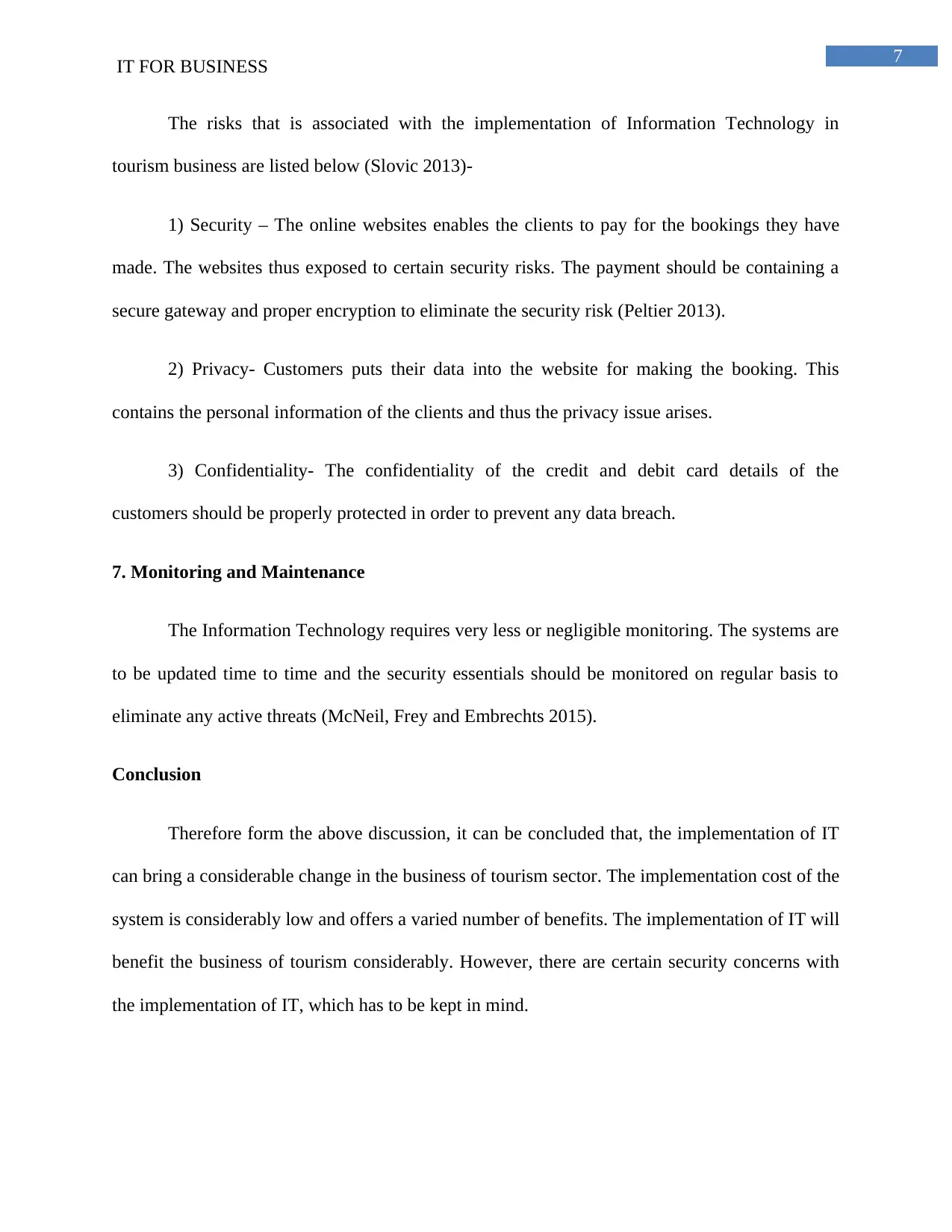
7
IT FOR BUSINESS
The risks that is associated with the implementation of Information Technology in
tourism business are listed below (Slovic 2013)-
1) Security – The online websites enables the clients to pay for the bookings they have
made. The websites thus exposed to certain security risks. The payment should be containing a
secure gateway and proper encryption to eliminate the security risk (Peltier 2013).
2) Privacy- Customers puts their data into the website for making the booking. This
contains the personal information of the clients and thus the privacy issue arises.
3) Confidentiality- The confidentiality of the credit and debit card details of the
customers should be properly protected in order to prevent any data breach.
7. Monitoring and Maintenance
The Information Technology requires very less or negligible monitoring. The systems are
to be updated time to time and the security essentials should be monitored on regular basis to
eliminate any active threats (McNeil, Frey and Embrechts 2015).
Conclusion
Therefore form the above discussion, it can be concluded that, the implementation of IT
can bring a considerable change in the business of tourism sector. The implementation cost of the
system is considerably low and offers a varied number of benefits. The implementation of IT will
benefit the business of tourism considerably. However, there are certain security concerns with
the implementation of IT, which has to be kept in mind.
IT FOR BUSINESS
The risks that is associated with the implementation of Information Technology in
tourism business are listed below (Slovic 2013)-
1) Security – The online websites enables the clients to pay for the bookings they have
made. The websites thus exposed to certain security risks. The payment should be containing a
secure gateway and proper encryption to eliminate the security risk (Peltier 2013).
2) Privacy- Customers puts their data into the website for making the booking. This
contains the personal information of the clients and thus the privacy issue arises.
3) Confidentiality- The confidentiality of the credit and debit card details of the
customers should be properly protected in order to prevent any data breach.
7. Monitoring and Maintenance
The Information Technology requires very less or negligible monitoring. The systems are
to be updated time to time and the security essentials should be monitored on regular basis to
eliminate any active threats (McNeil, Frey and Embrechts 2015).
Conclusion
Therefore form the above discussion, it can be concluded that, the implementation of IT
can bring a considerable change in the business of tourism sector. The implementation cost of the
system is considerably low and offers a varied number of benefits. The implementation of IT will
benefit the business of tourism considerably. However, there are certain security concerns with
the implementation of IT, which has to be kept in mind.
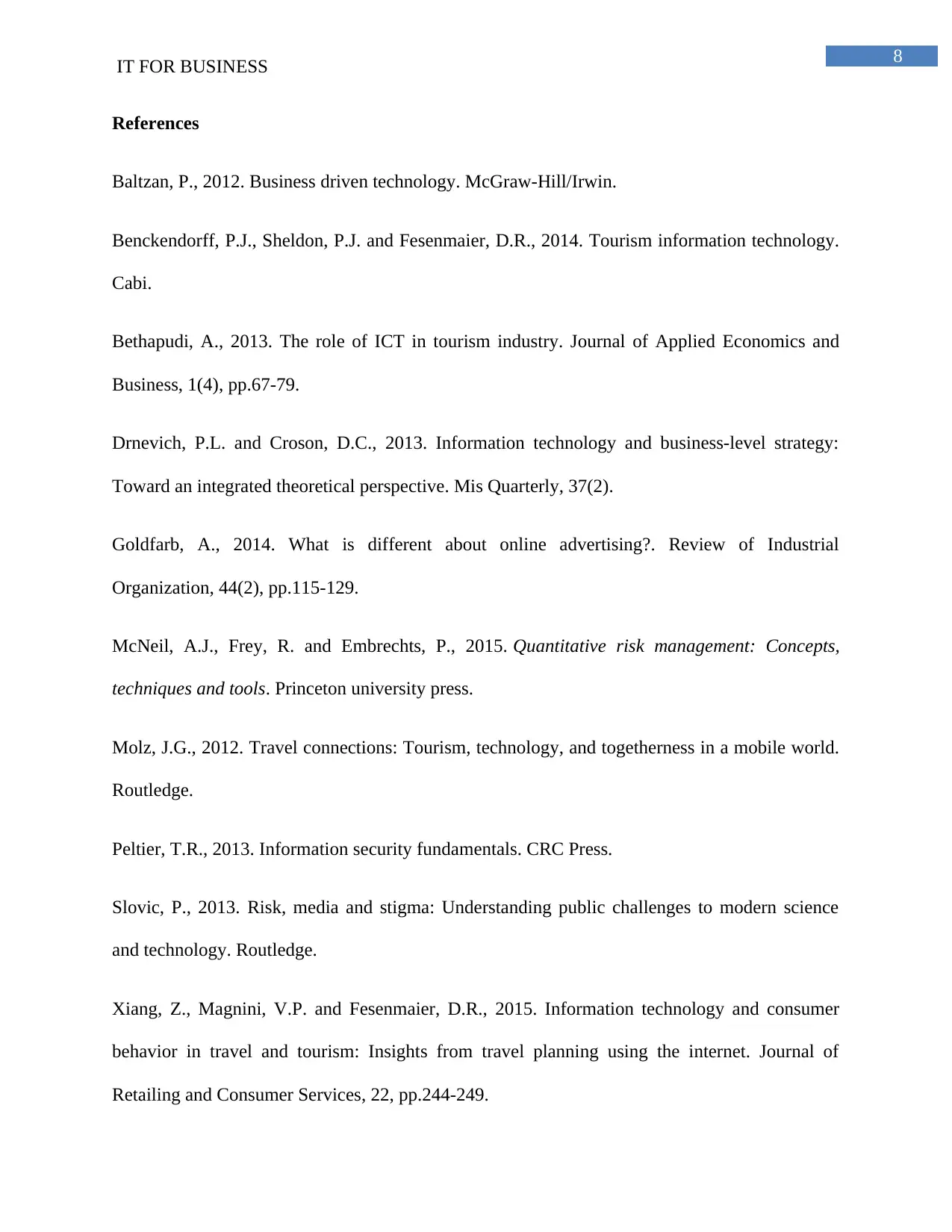
8
IT FOR BUSINESS
References
Baltzan, P., 2012. Business driven technology. McGraw-Hill/Irwin.
Benckendorff, P.J., Sheldon, P.J. and Fesenmaier, D.R., 2014. Tourism information technology.
Cabi.
Bethapudi, A., 2013. The role of ICT in tourism industry. Journal of Applied Economics and
Business, 1(4), pp.67-79.
Drnevich, P.L. and Croson, D.C., 2013. Information technology and business-level strategy:
Toward an integrated theoretical perspective. Mis Quarterly, 37(2).
Goldfarb, A., 2014. What is different about online advertising?. Review of Industrial
Organization, 44(2), pp.115-129.
McNeil, A.J., Frey, R. and Embrechts, P., 2015. Quantitative risk management: Concepts,
techniques and tools. Princeton university press.
Molz, J.G., 2012. Travel connections: Tourism, technology, and togetherness in a mobile world.
Routledge.
Peltier, T.R., 2013. Information security fundamentals. CRC Press.
Slovic, P., 2013. Risk, media and stigma: Understanding public challenges to modern science
and technology. Routledge.
Xiang, Z., Magnini, V.P. and Fesenmaier, D.R., 2015. Information technology and consumer
behavior in travel and tourism: Insights from travel planning using the internet. Journal of
Retailing and Consumer Services, 22, pp.244-249.
IT FOR BUSINESS
References
Baltzan, P., 2012. Business driven technology. McGraw-Hill/Irwin.
Benckendorff, P.J., Sheldon, P.J. and Fesenmaier, D.R., 2014. Tourism information technology.
Cabi.
Bethapudi, A., 2013. The role of ICT in tourism industry. Journal of Applied Economics and
Business, 1(4), pp.67-79.
Drnevich, P.L. and Croson, D.C., 2013. Information technology and business-level strategy:
Toward an integrated theoretical perspective. Mis Quarterly, 37(2).
Goldfarb, A., 2014. What is different about online advertising?. Review of Industrial
Organization, 44(2), pp.115-129.
McNeil, A.J., Frey, R. and Embrechts, P., 2015. Quantitative risk management: Concepts,
techniques and tools. Princeton university press.
Molz, J.G., 2012. Travel connections: Tourism, technology, and togetherness in a mobile world.
Routledge.
Peltier, T.R., 2013. Information security fundamentals. CRC Press.
Slovic, P., 2013. Risk, media and stigma: Understanding public challenges to modern science
and technology. Routledge.
Xiang, Z., Magnini, V.P. and Fesenmaier, D.R., 2015. Information technology and consumer
behavior in travel and tourism: Insights from travel planning using the internet. Journal of
Retailing and Consumer Services, 22, pp.244-249.
⊘ This is a preview!⊘
Do you want full access?
Subscribe today to unlock all pages.

Trusted by 1+ million students worldwide
1 out of 9
Related Documents
Your All-in-One AI-Powered Toolkit for Academic Success.
+13062052269
info@desklib.com
Available 24*7 on WhatsApp / Email
![[object Object]](/_next/static/media/star-bottom.7253800d.svg)
Unlock your academic potential
Copyright © 2020–2025 A2Z Services. All Rights Reserved. Developed and managed by ZUCOL.





